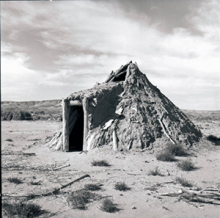Article
Also called “Yeibichei hogan,” a ceremonial hogan is constructed specifically for Navajo ceremonials. During ceremonials, these hogans are the space where sandpaintings are drawn and generally are only used for the length of the ceremonial. Ceremonial hogans are often cone-shaped, with an east facing door, and are considered male, as opposed to the dome-shaped female hogan constructed for daily use.
"Ceremonial hogan, Fruitland, NM, 1952," photograph, (2006_20_008). Farmington Museum, Farmington, NM. All rights reserved. Use with permission only.
Manuscripts
References
Crawford, Suzanne J., and Dennis F. Kelley
1981 American Indian Religious Traditions: An Encyclopedia. Santa Barbara, CA: ABC-
CLIO.
Frisbie, Charlotte Johnson
1980 Southwestern Indian Ritual Drama. Albuquerque: University of New Mexico Press.
Hirschfelder, Arlene, and Paulette Molin
2000 Hogan. Encyclopedia of Native American Religions, Updated Edition. New York:
Facts On File, Inc.
Waldman, Carl
1994 Hogan. Word Dance: The Language of Native American Culture. New York: Facts On
File, Inc.

